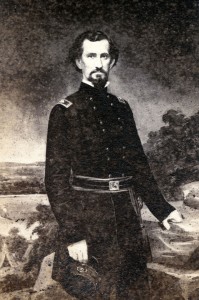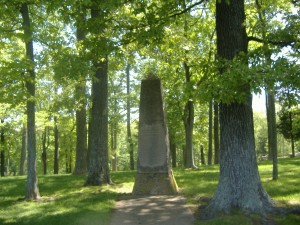Born in Maury County, Tennessee, on 19 May 1812, Felix Kirk Zollicoffer was of Swiss ancestry. He received some formal educational training before entering the newspaper business at age sixteen, and later rose to state prominence as editor of several influential newspapers, including the Nashville Republican Banner. His only military experience before the Civil War was a brief and undistinguished stint as lieutenant in the Second Seminole War in 1836. He served Tennessee as comptroller of the state treasury (1845-1849), state senator (1849-1852), and member of the U.S. Congress (1853-1859). Politically, Zollicoffer was a Unionist and member of the Whig Party until its demise in the mid-1850s. His moderate political stance led to his selection as a member of the ill-fated Washington Peace Conference in 1861.
With the firing on Fort Sumter, Zollicoffer faced the dilemma of maintaining his Union allegiance or supporting his state. He went the way of many others and declared his allegiance to the Confederacy and Tennessee. He was appointed brigadier general in the Confederate army on 9 July 1861 and was assigned to command the east Tennessee district. His specific purpose was to counter the 4,000 Unionist “Home Guards” at Camp Dick Robinson in central Kentucky, whom Confederate authorities believed could at any moment invade eastern Tennessee and control the strategic Cumberland Gap.
In early September, Confederate Major General Leonidas Polk violated Kentucky’s neutrality, which prompted Zollicoffer to send several hundred men through Cumberland Gap into southeastern Kentucky. His command consisted of seven infantry regiments and four cavalry battalions, the majority of whom were Tennesseans. Throughout the next several months, Zollicoffer probed southeastern Kentucky, skirmishing with Union troops on occasion¸ but never seriously threatening Camp Dick Robinson. General Albert Sidney Johnston, Confederate commanding general in the West, even advised Zollicoffer against making any further offensive movements, only later to recant and allow Zollicoffer discretion in attacking the enemy.
In November 1861, Zollicoffer sent word to Johnston that he was leaving troops at Cumberland Gap and preparing to advance toward central Kentucky. But Confederate president Jefferson Davis, unhappy with Zollicoffer’s performance thus far, appointed a native Kentuckian, Major General George B. Crittenden, to supercede Zollicoffer, the latter remaining with the army. Unfortunately, word of Crittenden’s appointment arrived after Johnston had approved Zollicoffer’s plan to establish a camp at Mill Springs, Kentucky, and, if not threatened by the enemy during the winter months ahead, launch a spring offensive into the central part of the state. On 29 November, Zollicoffer arrived at Mill Springs, a small community on the southern bank of the Cumberland River. With formidable bluffs edging the river, Zollicoffer had an excellent location for establishing winter quarters for his troops, while also presenting the Union command with an offensive threat to central Kentucky.
But less than two weeks later, Zollicoffer sent five infantry regiments, seven cavalry companies, and four pieces of artillery directly across the river to Beech Grove. In a letter to Johnston, Zollicoffer argued that his new position, with both flanks protected by a bend in the river, was a strong one that provided him an excellent opportunity to strike scattered Union troops, something that could not be accomplished from south of the river. When Crittenden arrived at Knoxville to assume command, he immediately ordered Zollicoffer to recross the Cumberland, but Zollicoffer chose to remain at Beech Grove, hopeful of convincing Crittenden of the wisdom of the move when he arrived in person in early January 1862. Such was not the case. In fact, the Confederate army was endangered by the presence of Union general George Thomas and 4,000 troops who had advanced to Logan’s Cross Roads, ten miles north of Beech Grove.
Faced with a Union force in front and river behind, on 19 January 1862, Crittenden ordered an advance on Union troops, hopeful of catching them by surprise. But a steady rain and muddy roads prevented rapid movement. During the ensuing battle, Zollicoffer, clad in a raincoat, decided to ride over to the Confederate left. With limited visibility due to smoke, fog, and rain, he unknowingly rode into Union ranks and engaged Union colonel Speed Fry in a conversation. Zollicoffer mistakenly believed that Fry’s 4th Kentucky regiment was part of his command and firing on fellow Confederate troops. As Fry returned to his men, another mounted officer emerged from the trees where the brief conversation had just taken place¸ firing his pistol into Union ranks and striking Fry’s horse Somewhat confused but acting on instinct, Fry returned the fire, as did his men. The second unidentified officer fled, but the one with whom Fry had just spoken fell from his mount, killed instantly. Upon viewing the body, there was no doubt as to the identity: It was General Felix Zollicoffer.
Like many other Southerners, Felix K. Zollicoffer was a citizen-soldier, thrust into war only after his state withdrew from the Union. His occupation of Beech Grove has remained an object of controversy and no real assessment of his military ability can be deduced from his brief service. Following the battle of Logan’s Cross Roads, Thomas sent Zollicoffer’s body into Confederate ranks for proper burial. His remains lie in the Old City Cemetery in Nashville.
- C. David Dalton
[Source: Heidler, David S. and Jeanne T. Heidler. Encyclopedia of the American Civil War: A Political, Social and Military History. W.W. Norton & Co. 2002. pp. 2171-2172]
For information on the Civil War Trust’s effort to save 16 acres of the Mill Springs battlefield, click here.
Further reading:
Myers, Raymond E. The Zollie Tree: General Felix K. Zollicoffer and the Battle of Mill Springs
Zollicoffer, Felix K. Speech of Mr. Zollicoffer, Of Tennesee, on the Kansas-Nebraska Bill (1854)
Felix Kirk Zollicoffer, Nashville City Cemetery
Information from Find-A-Grave
| Birth: | May 19, 1812 |
| Death: | Jan. 19, 1862 |
| Civil War Confederate Brigadier General. He was killed in action while leading his brigade during the Battle of Mill Springs (Fishing Creek, Logan’s Crossroads), Kentucky. While reconnoitering forward of his lines, he ran into the enemy lines, and was shot dead. A cenotaph exists in the Zollicoffer Confederate Cemetery on the battlefield, near Nancy, Kentucky, but Zollicoffer’s body was sent to his family in Nashville for burial.Family links: Parents: John Jacob Zollicoffer (1775 - 1840) Martha Kirk Zollicoffer (1786 - 1815)Spouse: Louisa P. Gordon Zollicoffer*Children: Octavia Zollicoffer Bond (1846 - 1941)* *Calculated relationship Cause of death: Shot Search Amazon for Felix Zollicoffer |
|
| Burial: Nashville City Cemetery Nashville Davidson County Tennessee, USA GPS (lat/lon): 36.14673, -86.7696 |
|
| Maintained by: Find A Grave Record added: Mar 19, 2000 Find A Grave Memorial# 8954 |
|




Pingback: On this Date in Civil War History: January 19, 1862 - Battle of Mill Springs (150th Anniversary) | This Week in the Civil War
Pingback: Minnesotans faced first Civil War combat action at Mill Springs 150 years ago | This Week in the Civil War
Pingback: Bluff City - Zollicoffer | Sullivan County, TNGenWeb